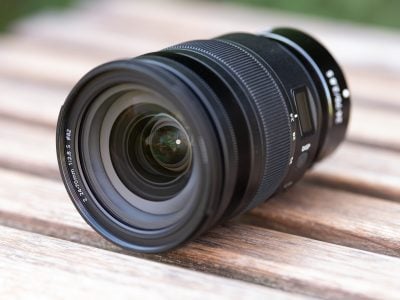Nikon Z 24-70mm f2.8 S review
-
-
Written by Thomas
Intro
The Nikon Z 24-70mm f2.8 S is a professional general-purpose zoom designed for Nikon’s full-frame Z-series mirrorless cameras. Announced in February 2019, it’s the fifth Z-mount lens, following the Z 14-30mm f4 S, Z 24-70mm f4 S, Z 35mm f1.8 S and Z 50mm f1.8 S, but crucially is the first native zoom with a fast f2.8 focal ratio.
Physically, the Z 24-70mm f2.8 S is a departure from the initial native zooms in the series. Not only is it the first with an f2.8 focal ratio, but it also dispenses with the retracting barrel mechanism of the f4 zooms. It’s also the first Z lens to feature a dedicated manual focusing ring in addition to a separate custom ring, as well as a customizable function button and an OLED display, the latter indicating focal length, aperture, focusing distance and depth-of-field in a similar way to the Zeiss Batis lenses. The Z 24-70mm f2.8 S is understandably heftier than the f4 models but it’s still shorter as well as 25% lighter than the existing DSLR version, the AF-S 24-70mm f2.8E ED VR.
To find out whether the new Nikon Z 24-70mm f2.8 S rightfully carries the “S” moniker I tested it against the Nikon Z 24-70mm f4.0 S on the 46MP Z7 body and also compare it against Nikon’s 24-70mm f2.8E VR shot on the 46MP D850. So if you like to know how Nikon’s brand new professional zoom performs, you’ve come to the right place! PS – if you’re interested in the other Z lenses in Nikon’s line-up check out our in-depth reviews: Nikon Z 14-30mm f4.0 S review / Nikon Z 24-70mm f4 S review / Nikon Z 35mm f1.8 S review / Nikon Z 50mm f1.8 S review / Nikon Z 85mm f1.8 S review..
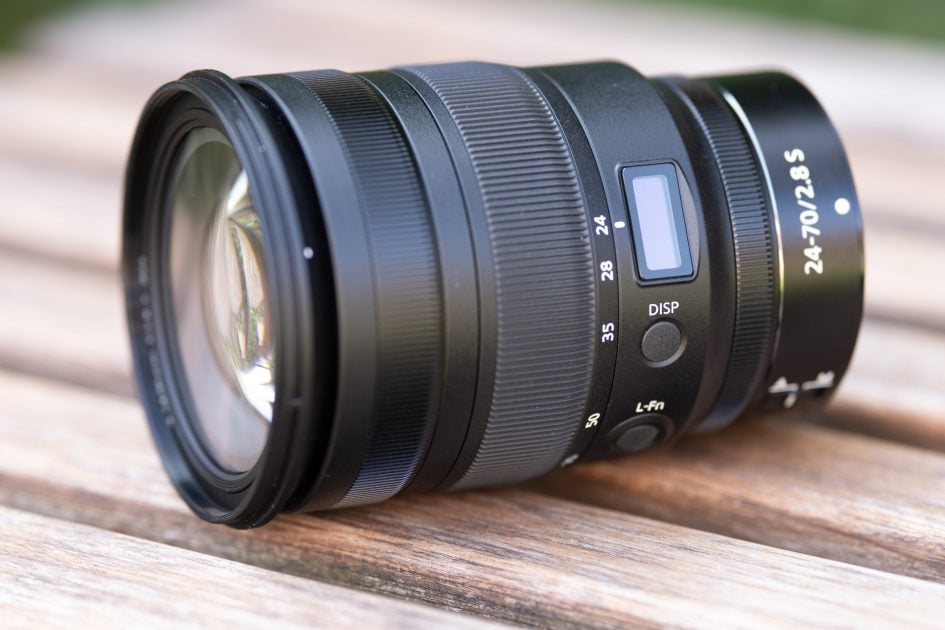
Facts from the catalog
As usual I’ll have a look at the technical data of the new Nikon Z 24-70mm f2.8 S first. I’ve rated the features with a [+] (or [++]), when it’s better than average or even state of the art, a [0] if it’s standard or just average, and [-] if there’s a disadvantage. For comparison I use the Nikon Z 24-70mm f4.0 S (“f4.0S” for short) and the Nikon 24-70mm f2.8E VR (“f2.8E VR”).
Size (diameter x length): 89 x 126mm (3.5 x 5.0in.) plus 41mm for the lens hood which is 109mm in diameter. Zooming in to 70mm extends the front-end of the lens (which is a single-barrel design) by another 30mm bringing the total length to 197mm (7.8in.). The f4.0S is only 78 x 88mm in its collapsed state. But zooming to 70mm adds 50mm (double-barrel design) and the lens hood another 41mm which brings the f4.0S to a total length of 179mm (7.0in.). Not much shorter than the new f2.8S. The f2.8E VR is still larger at 98 x 154mm + 49mm for the lens hood giving a total length of 203mm (8.0in.) independent of focal length. For an apples-to-apples comparison one has to add another 30.5mm for the FTZ adapter when using the f2.8E VR on a Nikon Z body. [0]
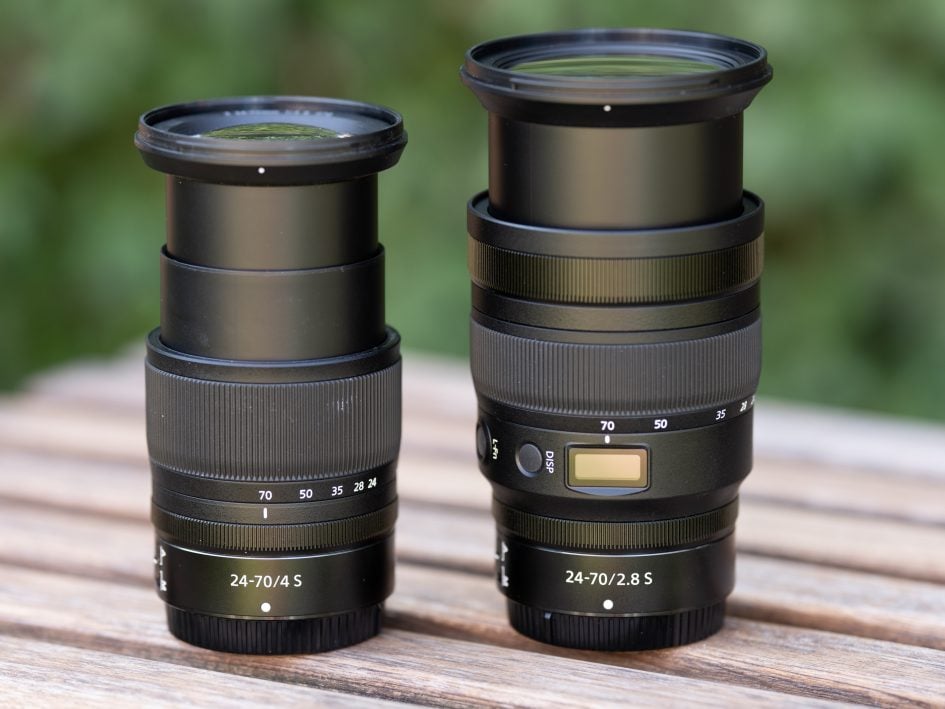
Above: Nikon Z 24-70mm f4.0 S (left) vs. Nikon Z 24-70mm f2.8 S (right)
Weight: 803g (28.4 oz.) plus 43g for the lens hood. That’s between the f4.0S at 497g (plus 28g for the lens hood) and the f2.8E VR at 1066g plus 60g for the lens hood plus another 133g for the FTZ adapter to use it on a Nikon Z body. Comparing lens plus body the Nikon Z 24-70mm f2.8 S on a Z7 is 1521g (54 oz.) while the Nikon 24-70mm f2.8E VR on a D850 weighs 2071g (73 oz.). [+]
Optics: The lens is a pretty complex design with 17 elements (including 2 special dispersion elements and 4 aspherical element) in 15 groups. That makes 30 glass/air surfaces where reflections can cause problems. The f4.0S has 14 elements in 11 groups vs. 20/16 for the f2.8E VR. All three lenses use Nikon’s Nano-coating to reduce flare, glare and ghosting but only the new Z 24-70mm f2.8 S profits from a new “ARNEO” anti-reflective coating. Nikon employs fluorine coating on the front and back of all three lenses to repel water, dust, and dirt and should make for easier cleaning. [+]
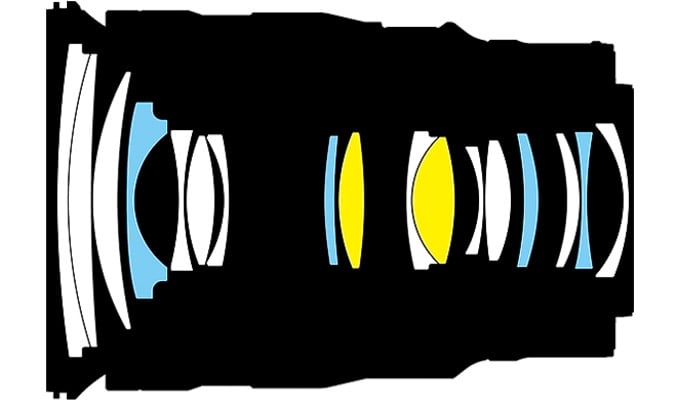
Closest focus distance is 0.37m (15in.) with a magnification of 1:4.2 in manual focus at 70mm focal length. This results in a working distance of 20cm when the lens hood is removed. A magnification of 1:10 is achieved at 0.77m giving a working distance of 0.56m with lens hood attached. The f4.0S goes down to 0.30m (11in.) achieving a better magnification of 1:3.1. The f2.8E VR achieves a magnification similar to the f4.0S. [0]
Filter-thread: 82mm just like the f2.8E VR. The f4.0S uses cheaper 72mm filters. [0]
Image stabilization: The lens offers no optical stabilization just like the f4.0S. But the Nikon Z bodies provide built-in sensor-shift stabilization over 5 axis – plus an optional electronic stabilization option in video mode. The f2.8E VR has optical image stabilization built in (pitch and yaw) which can be used together with the body-based image stabilization of a Nikon Z body. But in this case the body provides only roll correction, not the full 5 axis. [0]
Auto focus: Yes with built-in AF drive. Manual-focus override is by simply turning the dedicated focus ring at the front of the lens. The ring cannot be re-assigned another function nor can it be switched off – which is a pity as you might accidentally de-focus the lens. The focus ring has a variable gearing that allows for very precise manual focus when turned slowly. Unfortunately this feature cannot be switched to linear gearing which makes smooth focus pulling for videographers almost impossible. The Nikon Z 24-70mm f2.8 S is the first Nikon Z lens to feature an OLED display indicating focal length, aperture or focusing distance (in m or ft.) and depth-of-field. The display is hard to read under sunny conditions in its default setting but it can be made as bright as the top display on the Z7. You can switch through the different display types using the DISP-button.

There’s also a function button L-Fn on the lens that is set to AE/AF lock as default but can be assigned 21 different functions. On the f4.0S focusing works the same except that it is done with the multi-function ring at the back of the lens – if you didn’t assign another operation to this ring. There’s also no OLED display or L-Fn button on the f4.0S. Focus on the f2.8E VR works differently as it has a direct linear mechanical coupling between the focus ring and the focus action. It also offers the distance markings that normally come with lenses designed for DSLRs and the focus ring does only that: focusing. [+]
Lens profile: The lens comes with a lens profile which can be controlled from the camera. Vignette control offers the usual options of High, Normal, Low and Off. Diffraction compensation and Auto distortion control can be activated or deactivated. While Adobe’s RAW converter ignores these settings and treats them as if they are set to Normal/On Nikon’s Capture NX-D allows to change the settings when developing RAWs. The Nikon Z 24-70mm f4.0 S also comes with a lens profile but Auto distortion control cannot be switched off – neither in camera nor in Capture NX-D. The Nikon 24-70mm f2.8E VR does not come with a lens profile but Lightroom and Photoshop provide one with vignette and distortion control. [+]
Covers full frame/FX or smaller. Same with the competition. [+]
Price: 2500 EUR (incl. 19% VAT) / 2300 USD. The f4.0S is 850 EUR / 1000 USD bought solo or cheaper if you buy it in a kit together with the Z camera. The f2.8E VR currently goes for 2030 EUR / 2200 USD. I’d consider the price of the new lens relatively fair for a professional 24-70/2.8 zoom from a camera manufacturer. [0]
The lens comes with a pouch that’s just as flimsy as the pouch of the other Z lenses and has no strings to pull it close. So if you put the lens in your bag it might easily slip out of its pouch and bang around unprotected. This is simply unacceptable for a lens costing north of 2000 EUR/USD. The lens hood is included and locks in place to avoid accidentally falling off plus it is reversible for transport. Plus it is coated like black velvet on the inside to reduce reflexes. The f2.8E VR has a much nicer padded lens case and its lens hood also has a lock. The lens hood of the f4.0S has no lock. [0]
Aperture ring: the multi-function control ring at the back of the f2.8S can be assigned to operate the aperture (this is the default) or exposure compensation. The aperture is actuated electromagnetically which makes it the equivalent of an E-type Nikon lens like the f2.8E VR and puts away with the mechanical coupling that Nikon uses on all older lenses. The multi-function control ring on the f4.0S can control aperture, exposure compensation or focusing. The f2.8E VR has no aperture ring. [+]
Sealing: yes, a rubber grommet at the lens-mount plus further special weather-sealing throughout the construction, just like the f4.0S and the f2.8E VR. [+]
The score in the “features-department” is 0[-]/6[0]/7[+]. The lens is smaller and lighter than its F-mount equivalent and sports a complete set of controls and a nifty OLED display. Initially it may be a bit more expensive than Nikon’s 24-70mm f2.8E VR but that was to be expected. But especially in light of the asking price the laughable lens pouch is the biggest disappointment.
Two Nikon Z 24-70mm zoom lenses
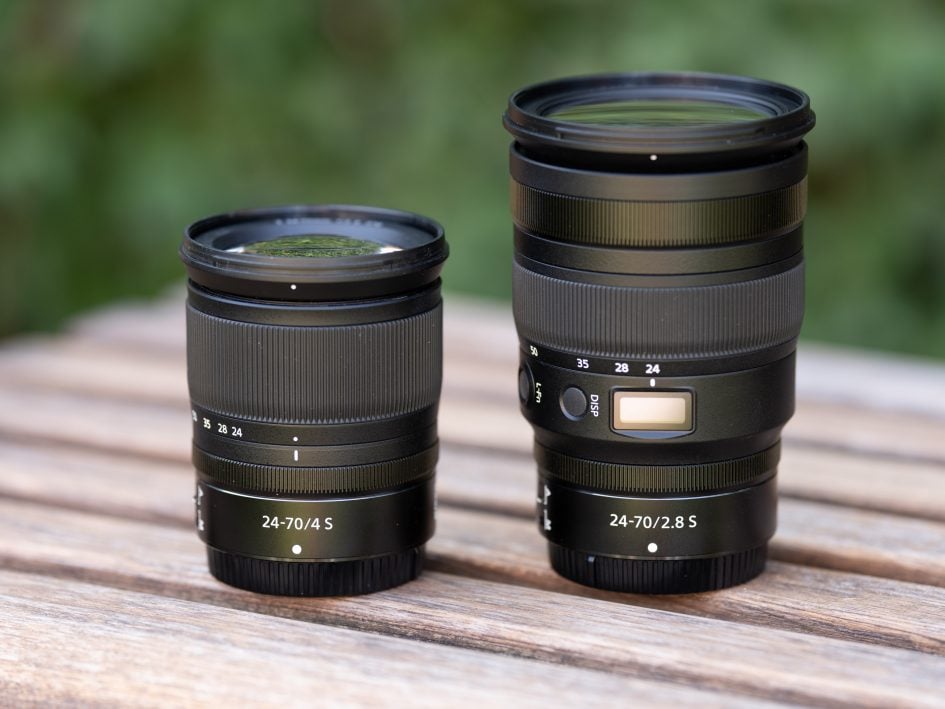
Above: Nikon Z 24-70mm f4.0 S (left) vs. Nikon Z 24-70mm f2.8 S (right)
Alternatives
The market for full-frame 24-70mm zooms is pretty crowded but no other manufacturer offers a version for Nikon mirrorless Z bodies yet. So the alternative is either Nikon’s Z 24-70mm f4.0 S or to use other lenses via Nikon’s FTZ adapter adding 30.5mm in length and 133g in weight:
- Nikon’s Z 24-70mm f4.0 S is the only alternative available in Z-mount. It is 300g lighter and costs much less than the Z 24-70mm f2.8 S. But that comes with a one stop slower focal ratio of f4.0. The lens got a Highly Recommended in my Nikon Z 24-70mm f4.0 S review.
- Nikon also has the F-mount AF-S 24-70mm f2.8E ED VR from 2015 for 2030 EUR / 2200 USD. For more information see my Nikon 24-70mm f2.8E VR review where it got a Highly Recommended. And you can still get the older AF-S 24-70mm f2.8G ED version from 2007 which is not stabilized and sells for 1700 EUR / 1800 USD which came Highly Recommended tested on a 36MP D800 in my Nikon 24-70mm f2.8G ED review.
- Sigma offers the stabilized Sigma 24-70mm f2.8 DG OS HSM Art (1230 EUR / 1300 USD). See my Sigma 24-70mm f2.8 Art review where it earned a recommendation.
- Tamron’s latest model is the stabilized SP AF 24-70mm 2.8 Di VC USD G2 for about 1150 EUR / 1200 USD. It earned a Recommended in my Tamron SP 24-70mm f2.8 VC G2 review.
- Tokina offers the AT-X Pro 24-70mm 2.8 FX from 2015 (900 EUR / 850 USD) which lacks built-in stabilization. But mounting it via FTZ adapter stabilizes pitch, yaw and roll through a Nikon Z body.
Here is the angle of view that the new Nikon Z 24-70mm f2.8 S covers with its 2.9x zoom:

Above: Nikon Z 24-70mm f2.8 S coverage on Nikon Z7 (FF/FX) body at 24mm (left) and 70mm (right)
Focus and zoom
Focus accuracy and repeatability is critical to consistently produce sharp shots. Repeatability (the accuracy of focus on the same subject after repeated focus-acquisition) of this lens at 70mm focal length is very good (measured 99.3% in Reikan FoCal) with no outliers over a series of 40 shots. There is no focus variation whether the lens focuses from a closer distance or from infinity and I didn’t detect any hunting. At 70mm focal length the lens focuses in around 0.5 sec from infinity to 0.77m (1:10 magnification), which is a little slower than the very fast Z 24-70mm f4.0 S or the AF-S 24-70mm f2.8E ED VR on a D850 or a Z7 (via FTZ adapter).
The zoom ring turns through 85 degrees the way Nikon users are used to and has a 21mm wide rubber surface with a good grip. It turns pretty stiff and can hardly be operated with one finger. The lens shows some zoom creep beyond 50mm focal length. The lens control ring is only 8mm wide and is located closer to the camera. It has no rubberized surface but moves super smooth and can easily be operated even with your pinky. The focus ring is 12mm wide, located at the front of the lens, and moves smoothly.
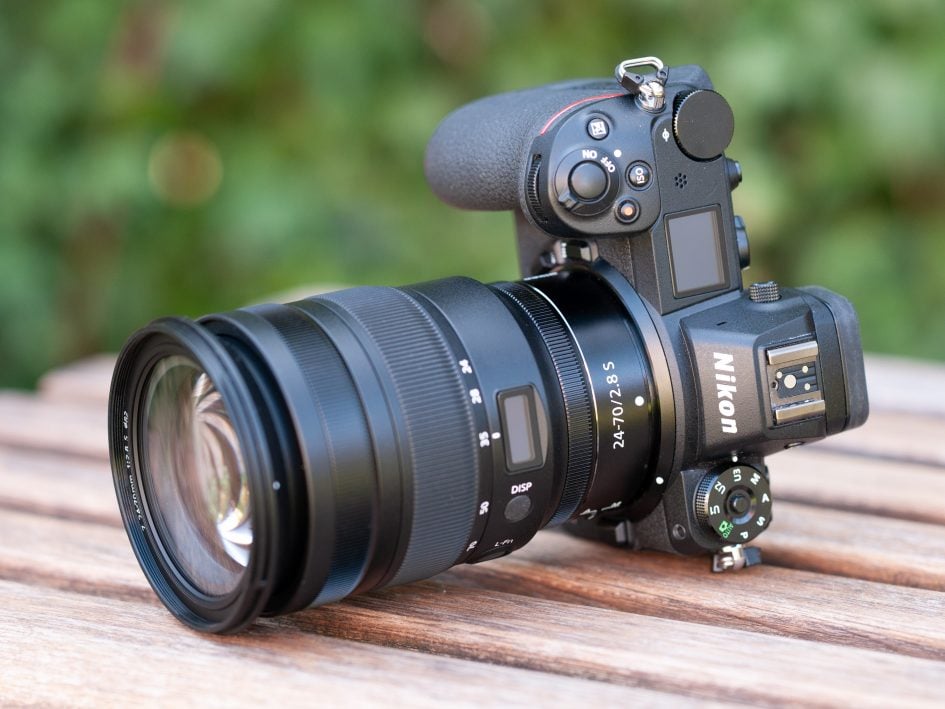
AF-operation of the new lens and image stabilization of the Z7 is inaudible from the outside. If you record video with the built-in microphone the AF-drive produces only a very slight noise only a little louder than from the Z 24-70mm f4.0 S. Plus you can control the aperture smoothly and without noise from the control ring on the lens. Mount the Nikon 24-70mm f2.8E VR via the FTZ adapter and you notice a huge difference in noise.
As you pull focus, you’ll notice some focus breathing: the image becomes less magnified at closer focusing distances. When I adjusted the focus from infinity to 0.77m on the new Nikon at 70mm focal length, I measured a 3.5% decrease in magnification. The same test at 24mm focal length produced a 0.7% decrease. The Z 24-70mm f4.0 S is a bit better but the new zoom still should satisfy videographers. The Nikon 24-70mm f2.8E VR shows a 1.4% increase in magnification at 70mm focal length, while decreasing magnification by 2.6% at 24mm focal length.
I also tested whether Nikon’s newest zoom lens allows you to change the focal length without altering its focus. This characteristic is called parfocal. I manually focused the lens at 70mm and then slowly zoomed back to 24mm checking focus on the way. The Z 24-70mm f2.8 S did keep its focus but not quite perfect: when zooming back the lens became gradually less sharp and then suddenly snapped back into perfect focus. See the following 100% crops shot at f4.0 and a focal length of 39mm resp. 38mm without re-focusing:
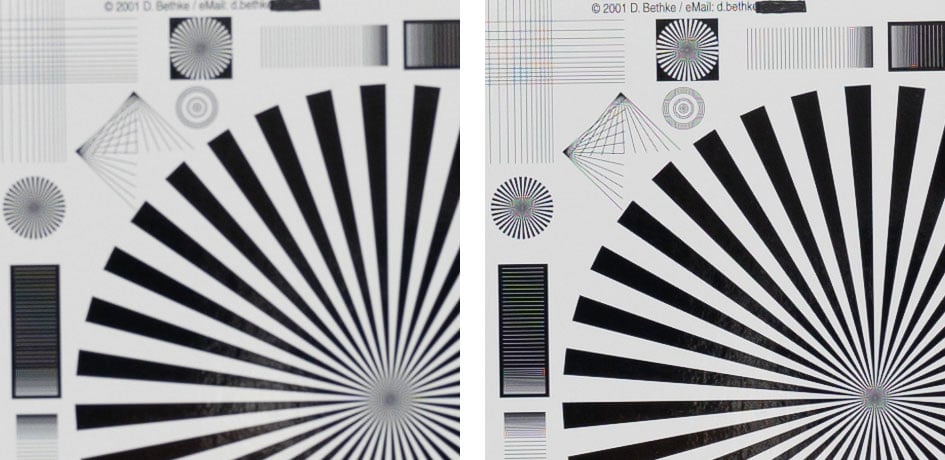
Above: Nikon Z 24-70mm f2.8 S at 39mm, f4.0 (left) and 38mm, f4.0 (right), 100% crops from center
Obviously this zoom lens is not optically designed to be parfocal but Nikon implemented a control curve to compensate for the effects of zooming on focus. The implementation of this perfectly valid idea might be good enough for videogaphers filming at lower resolutions. But for shooting high resolution photos the old rule still applies: When you change focal length (even a tiny bit), re-focus! Btw.: The Z 24-70mm f4.0 S works the same way.
Next check out my quality results!
Check prices on the Nikon Z 24-70mm f2.8 S at B&H, Adorama and WEX!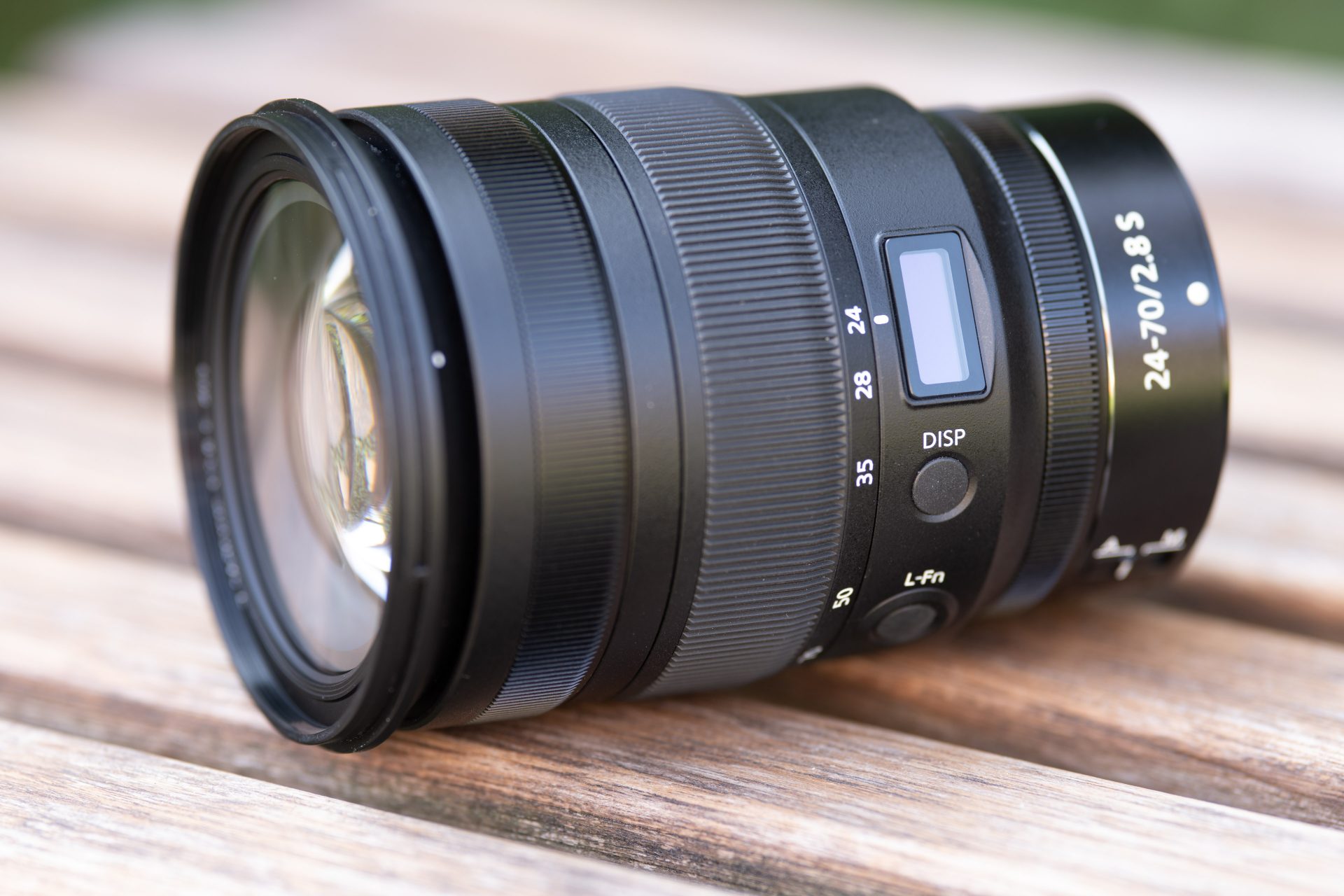
 The Nikon Z 24-70mm f2.8 S is a general-purpose zoom designed for Nikon’s full-frame Z-series mirrorless cameras and offers a one stop faster focal ratio than the Z 24-70mm f4.0 S 'kit zoom'. It performed very well in all of my tests regarding contrast, resolution, focus speed and reliability, colour aberrations, and coma, producing very good image quality on a demanding 46MP Z7 body. It is equipped with a useful OLED display, a dedicated focus ring (in addition to the multi-function ring), and a customizable function button, plus the lens is well-sealed against the elements. What’s not to like? Well, the Z 24-70mm f2.8 S is an expensive lens, clearly bigger and 300g heavier than its smaller sibling, the Z 24-70mm f4.0 S. So is it worth spending the extra and accommodating the heft, and while we’re it at, is it also the rightful successor to Nikon's professional F-mount workhorse, the 24-70mm f2.8E VR? I'd say "Yes" on both accounts. The Z 24-70mm f2.8 S delivers the highest optical quality including the best Bokeh and very usable close-up performance in a package that is smaller and lighter than the f2.8E VR and has the decisive advantage of a one stop larger focal ratio over the f4.0 S. So if you want the best 24-70mm zoom for your Nikon Z bodies, get the new Z 24-70mm f2.8 S: it comes Highly Recommended!
The Nikon Z 24-70mm f2.8 S is a general-purpose zoom designed for Nikon’s full-frame Z-series mirrorless cameras and offers a one stop faster focal ratio than the Z 24-70mm f4.0 S 'kit zoom'. It performed very well in all of my tests regarding contrast, resolution, focus speed and reliability, colour aberrations, and coma, producing very good image quality on a demanding 46MP Z7 body. It is equipped with a useful OLED display, a dedicated focus ring (in addition to the multi-function ring), and a customizable function button, plus the lens is well-sealed against the elements. What’s not to like? Well, the Z 24-70mm f2.8 S is an expensive lens, clearly bigger and 300g heavier than its smaller sibling, the Z 24-70mm f4.0 S. So is it worth spending the extra and accommodating the heft, and while we’re it at, is it also the rightful successor to Nikon's professional F-mount workhorse, the 24-70mm f2.8E VR? I'd say "Yes" on both accounts. The Z 24-70mm f2.8 S delivers the highest optical quality including the best Bokeh and very usable close-up performance in a package that is smaller and lighter than the f2.8E VR and has the decisive advantage of a one stop larger focal ratio over the f4.0 S. So if you want the best 24-70mm zoom for your Nikon Z bodies, get the new Z 24-70mm f2.8 S: it comes Highly Recommended!



